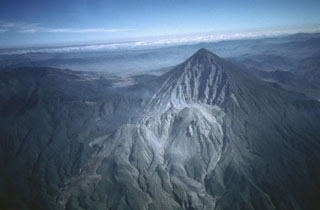Report on Santa Maria (Guatemala) — 21 February-27 February 2007
Smithsonian Institution / US Geological Survey
Weekly Volcanic Activity Report, 21 February-27 February 2007
Managing Editor: Sally Sennert.
Please cite this report as:
Global Volcanism Program, 2007. Report on Santa Maria (Guatemala) (Sennert, S, ed.). Weekly Volcanic Activity Report, 21 February-27 February 2007. Smithsonian Institution and US Geological Survey.
Santa Maria
Guatemala
14.757°N, 91.552°W; summit elev. 3745 m
All times are local (unless otherwise noted)
Based on satellite imagery, the Washington VAAC reported that diffuse ash plumes from Santa María's Santiaguito lava dome complex drifted mainly W and N during 22, 23, and 25-27 February. INSIVUMEH reported seven explosions produced ash plumes that rose to altitudes of 4.4-4.6 km (14,400-15,100 ft) a.s.l. and drifted SW on 26 February. Avalanches occurred from lava-flow fronts on the SW flanks and from the S edge of Caliente Dome. A hotspot was seen on satellite imagery. On 27 February, explosions occurring at an approximate rate of 3 per hour produced ash plumes that reached altitudes of 4.8 km (15,700 ft) a.s.l. Occasionally explosions were accompanied by pyroclastic flows that traveled SW.
Geological Summary. Symmetrical, forest-covered Santa María volcano is part of a chain of large stratovolcanoes that rise above the Pacific coastal plain of Guatemala. The sharp-topped, conical profile is cut on the SW flank by a 1.5-km-wide crater. The oval-shaped crater extends from just below the summit to the lower flank, and was formed during a catastrophic eruption in 1902. The renowned Plinian eruption of 1902 that devastated much of SW Guatemala followed a long repose period after construction of the large basaltic andesite stratovolcano. The massive dacitic Santiaguito lava-dome complex has been growing at the base of the 1902 crater since 1922. Compound dome growth at Santiaguito has occurred episodically from four vents, with activity progressing E towards the most recent, Caliente. Dome growth has been accompanied by almost continuous minor explosions, with periodic lava extrusion, larger explosions, pyroclastic flows, and lahars.
Sources: Washington Volcanic Ash Advisory Center (VAAC), Instituto Nacional de Sismologia, Vulcanologia, Meteorologia, e Hidrologia (INSIVUMEH)

